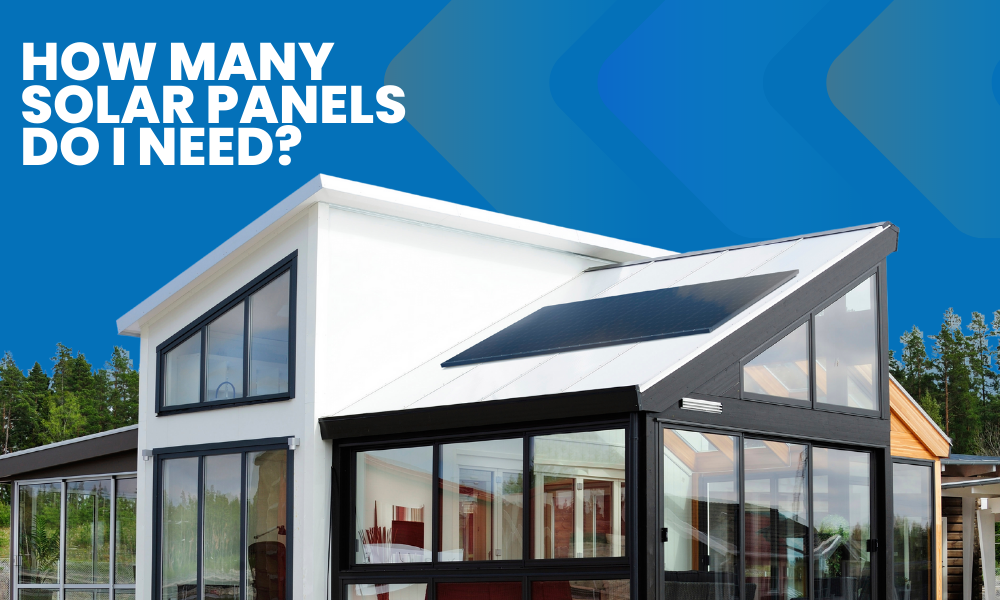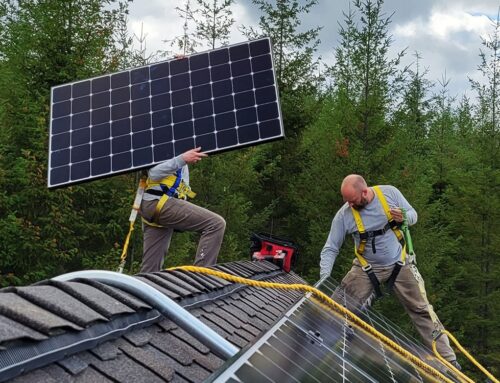One of the first questions homeowners ask when going solar is, “How many solar panels do I need to power my home?”
The goal for any solar project should be 100% electricity offset and maximum savings—not necessarily to cram as many panels on a roof as possible. So, the number of panels you need to power a house varies based on three main factors:
- Electricity Consumption
- Sun exposure
- Solar panel power rating
Here, we’ll show you how to manually calculate how many panels you’ll need to power your home. Once you have an estimate for the number of panels, you’re one step closer to figuring out how much solar costs for your home and how much you can save on electricity bills.
If you’d rather skip the math, connect with us at Sunergy Systems for answers.
How many solar panels do you need to power a house?
While it varies from home to home, the average U.S. home typically needs between 10 and 20 solar panels to entirely offset their average annual electricity consumption. The goal of most solar projects is to offset 100% of the electric bill, so your solar system is sized to fit your average electricity use. Here’s a basic equation that can be used to get an estimate of how many solar panels you need to power your home:
Solar panel wattage x peak sun hours x number of panels = daily electricity use
Obviously, electricity use, peak sun hours, and panel wattage will be different for everyone. To simplify the equation before showing how to figure out each variable, here is an example scenario based on national averages.
- First, establish daily electricity use in kWh, the national average (for specifics, check your electric bill)
- Next, divide by the average peak sun hours for the city
- Finally, divide again by the power rating of each panel — the most common is 400W or 0.4 kW
Example for the national average:
According to the U.S. Energy Information Administration (EIA), the average U.S. household in 2021 used 10,632 kilowatt-hours (kWh) of electricity per year. That’s equal to:
- 886 kWh per month
- ~30 kWh per day
30 kWh per day / 5 peak sun hours = 6 kW
6 kW / 0.4 kW = 15 panels
But it’s important to note that this usage varies a lot from state to state. For example, the average daily usage was about 18 kWh in Hawaii and 40 kWh in Louisiana—that’s quite a spread.
Here are some specifics to find out how many kilowatt-hours you use to run YOUR house.
The easiest way to find your daily electricity usage is to pull up some recent utility bills. Your bill should show your usage for 30 days (or whatever your payment period is), and you can use this to get a sense of your daily electricity consumption. Just take the total usage during the period and divide it by the number of days. Electricity usage varies from month to month, so the more bills you can average together, the more accurate your calculation will be.
Once you have your daily electricity usage, the next step is to figure out how many peak sun hours your system will get per day!
Next, determine how many peak sun hours your location gets.
A big factor in determining how many solar panels you need to power your home is the amount of sunlight you get, known as peak sun hours. A peak sun hour is when the intensity of sunlight (known as solar irradiance) averages 1,000 watts per square meter, or 1 kW/m2. In the US, the average peak sun hours range from over 5.75 hours per day in the Southwest to less than 4 hours per day in the northernmost parts of the country.
Google “Peak sun hours in Seattle” or use this peak sun hours map to get an estimated figure for your location.
Then, pick a solar panel power rating.
The final variable is how much electricity each solar panel can produce per peak sun hour. This is called the power rating, and it’s measured in Watts.
Solar panel power ratings range from 250W to 450W. Based on solar.com sales data, 400W is by far the most popular power rating and provides a great balance of output and Price Per Watt (PPW).
If you have limited roof space, you may consider a higher power rating to use less panels. If you want to spend less per panel, you may consider a lower wattage. Everybody has different goals, and you should feel free to choose the panels that best suit your needs.
For the purposes of our example scenario, we’ll use a different panel, 420 W.
Now that we have our three variables, we can calculate how many solar panels it takes to power a house.
- Daily electricity consumption: 30 kWh
- Average peak sun hours: 5.2 hours per day
- Average panel wattage: 420W
To solve for the number of solar panels, we can rewrite the equation above like this:
Daily electricity consumption/peak sun hours/panel wattage = number of solar panels
Now let’s plug in our example figures:
30 kWh / 5.2 peak sun hours / 420W = 13.7 panels
If we round up, it takes 14 solar panels to power the sample household and meet the goal of 100% electricity offset.
If this is getting too complex, we’ve got an easier solution for you. Visit Sunergy Systems for more information. Try our FREE QUOTE or Solar Calculator, where we can do the math quickly and specifically for your home.









